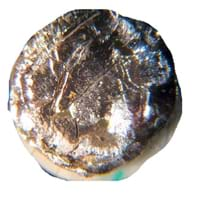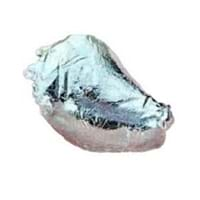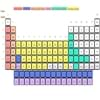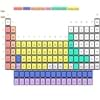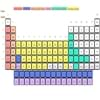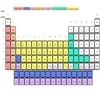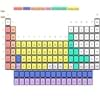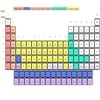Americium vs Technetium
Periodic Table
Symbol
Am
Tc
Group Number
Not Available
7
11
Period Number
7
5
Block
f block
d block
Element Family
Actinide
Transition Metal
CAS Number
7440359
99+
7440268
99+
Space Group Name
P63/mmc
P63/mmc
Space Group Number
194.00
5
194.00
5
Facts
Interesting Facts
- Americium metal is produced by bombarding Plutonium with Neutrons.
- Americium metal was discovered as a by-product while testing an atomic bomb (Manhattan Project).
- Original name of Technetium was Masurium.
- At the time of its discovery it found in sample of Molybdenum.
Sources
Obtained By Bombarding Plutonium with Neutrons
Made by Bombarding Molybdenum with Deuterons
History
Who Discovered
Glenn T. Seaborg, Ralph A. James, Leon O. Morgan, Albert Ghiorso
Emilio Segrè and Carlo Perriero
Discovery
In 1944
In 1937
Abundance
Uses
Uses & Benefits
- Americium metal is used in smoke detection alarms.
- In the future, this metal has a potential to be used in batteries of spacecrafts.
- Technetium is a radioactive metal and hence it is used for medical studies and other research purposes.
Industrial Uses
NA
NA
Medical Uses
NA
NA
Other Uses
Alloys, Nuclear Research, Research Purposes
Alloys, Nuclear Research, Research Purposes
Biological Properties
Toxicity
Toxic
Low Toxic
Present in Human Body
No
No
In Blood
0.00 Blood/mg dm-3
37
0.00 Blood/mg dm-3
37
In Bone
0.00 p.p.m.
36
0.00 p.p.m.
36
Physical Properties
Melting Point
994.00 °C
99+
2,200.00 °C
9
Boiling Point
2,607.00 °C
99+
4,877.00 °C
7
Appearance
Physical State
Solid
Solid
Color
Silvery White
Shiny Gray
Luster
NA
NA
Hardness
Speed of Sound
Not Available
16,200.00 m/s
1
Optical Properties
Allotropes
No
No
α Allotropes
Not Available
Not Available
β Allotropes
Not Available
Not Available
γ Allotropes
Not Available
Not Available
Chemical Properties
Chemical Formula
Am
Tc
Isotopes
Known Isotopes
16
23
18
21
Electronegativity
Pauling Electronegativity
1.30
32
1.90
11
Allred Rochow Electronegativity
1.20
27
1.36
20
Allen Electronegativity
Not Available
1.51
28
Electropositivity
Pauling Electropositivity
2.70
22
2.10
99+
Ionization Energies
1st Energy Level
578.00 kJ/mol
99+
702.00 kJ/mol
36
2nd Energy Level
1,158.00 kJ/mol
99+
1,470.00 kJ/mol
99+
3rd Energy Level
2,132.00 kJ/mol
99+
2,850.00 kJ/mol
33
4th Energy Level
3,493.00 kJ/mol
99+
Not Available
Electrochemical Equivalent
3.02 g/amp-hr
17
0.52 g/amp-hr
99+
Electron Work Function
Not Available
Not Available
Other Chemical Properties
Ionization, Radioactive Isotopes, Radioactivity, Solubility
Anti Corrosion, Ionization, Radioactive Isotopes, Radioactivity, Solubility
Atomic Properties
Atomic Number
95
23
43
99+
Electron Configuration
[Rn] 5f7 7s2
[Kr] 4d5 5s2
Crystal Structure
Double Hexagonal Close Packed (DHCP)
Hexagonal Close Packed (HCP)
Crystal Lattice
DHCP-Crystal-Structure-of-Americium.jpg#100
HCP-Crystal-Structure-of-Technetium.jpg#100
Atom
Number of Protons
95
23
43
99+
Number of Neutrons
148
12
55
99+
Number of Electrons
95
23
43
99+
Radius of an Atom
Atomic Radius
173.00 pm
21
136.00 pm
99+
Covalent Radius
180.00 pm
21
147.00 pm
37
Van der Waals Radius
244.00 pm
10
200.00 pm
28
Atomic Weight
243.00 amu
20
98.00 amu
99+
Atomic Volume
17.86 cm3/mol
29
8.50 cm3/mol
99+
Adjacent Atomic Numbers
Valence Electron Potential
44.00 (-eV)
40
180.00 (-eV)
3
Lattice Constant
346.81 pm
99+
273.50 pm
99+
Lattice Angles
π/2, π/2, 2 π/3
π/2, π/2, 2 π/3
Lattice C/A Ratio
Not Available
1.60
5
Mechanical Properties
Density
Density At Room Temperature
12.00 g/cm3
30
11.00 g/cm3
34
Tensile Strength
Not Available
Not Available
Viscosity
Not Available
Not Available
Vapor Pressure
Vapor Pressure at 1000 K
0.00 (Pa)
13
Not Available
Elasticity properties
Poisson Ratio
Not Available
Not Available
Other Mechanical Properties
NA
NA
Magnetic Properties
Magnetic Characteristics
Specific Gravity
13.67
15
11.50
24
Magnetic Ordering
Paramagnetic
Paramagnetic
Electrical Properties
Electrical Property
Unknown
Conductor
Resistivity
0.69 nΩ·m
99+
200.00 nΩ·m
18
Electrical Conductivity
0.02 106/cm Ω
99+
0.07 106/cm Ω
30
Electron Affinity
Not Available
53.00 kJ/mol
18
Thermal Properties
Specific Heat
0.11 J/(kg K)
99+
0.21 J/(kg K)
29
Molar Heat Capacity
62.70 J/mol·K
1
24.27 J/mol·K
99+
Thermal Conductivity
10.00 W/m·K
99+
50.60 W/m·K
30
Critical Temperature
Not Available
Not Available
Thermal Expansion
Not Available
7.10 µm/(m·K)
99+
Enthalpy
Enthalpy of Vaporization
Not Available
660.00 kJ/mol
6
Enthalpy of Fusion
14.39 kJ/mol
24
23.01 kJ/mol
9
Enthalpy of Atomization
268.00 kJ/mol
40
649.00 kJ/mol
8
Standard Molar Entropy
Not Available
181.10 J/mol.K
2
|
||
|
||
|
